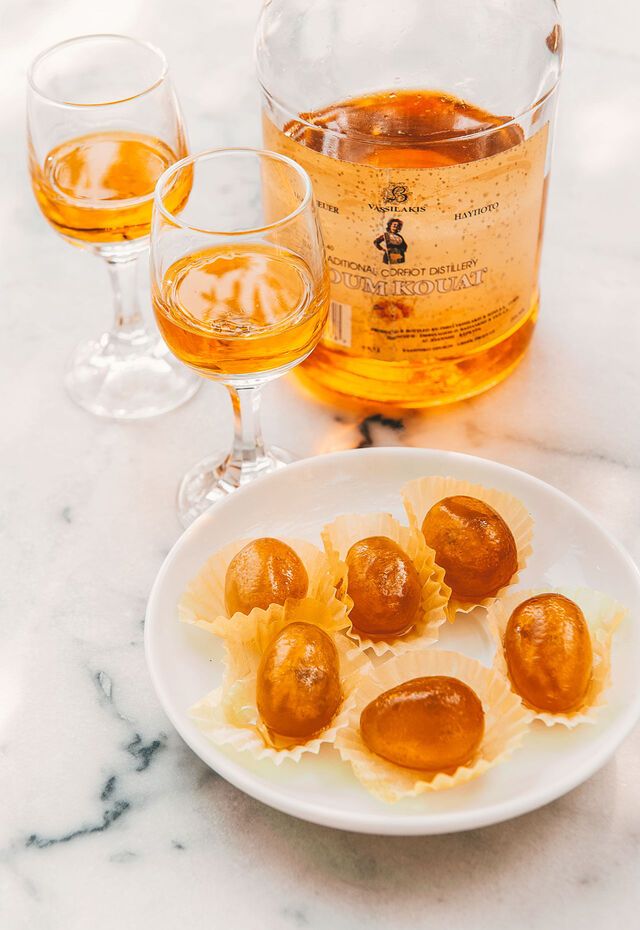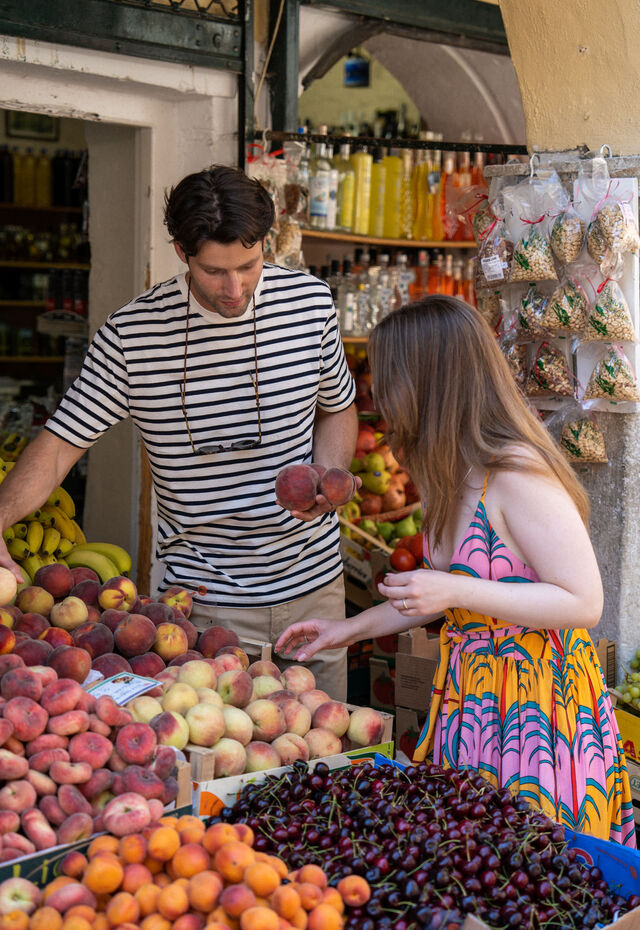The best food & drink experiences in Corfu


OVERVIEW
Just as you can see and feel Corfu’s rich cultural identity, so too can you smell and taste it. The Venetians (at a time when most of Greece was under Ottoman rule) left the best of themselves on the food front, but you’ll also find British and other influences in Corfu – all of which have given the island a unique local flavour.
As you wander around Corfu Old Town – down the cantounia (pedestrianised little roads) and past stores selling local products and open-air markets – you’ll piece together a unique history. The Fortezza Vecchia and Nuova (Old and New Fortress), Campiello (atmospheric old quarter) and Spianada Square all carry their Venetian legacy in their names. Just as sofrito (pan-fried beef in a parley and garlic sauce, sautéed with wine), pastitsada (beef or rooster casserole with pasta), bianco (a succulent fish-based dish) and bourdeto (a spicy fish dish whose red colour comes mostly from peppers) do in tavernas.
Yes, Corfu’s food influences are often Venetian, but the taste is unmistakably Greek. The olive oil, honey and wine you enjoy on Corfu will most likely be local. Even the beer could be. And let’s not mention the dairy and meat products or the fresh fish. You’ll discover it all on a food tour – definitely one of the best things to do In Corfu, whether it’s a full-day experience or spread throughout your holiday. Just don’t forget to bring your appetite.
DON'T MISS
Corfu food & drink highlights
Organised food tours in Corfu typically focus on markets, local producers and restaurants in the Old Town, but you should also explore the rest of the island and add visits to a winery, olive press or other producers out of town.
The local drinks
Who would have expected that ginger beer would be part of Corfu’s culinary culture? And yet, ask for a ‘tsitsibira’ and that’s what you’ll get. You have the British to thank for this tangy delight - and, specifically, a brewery that was founded in 1842 to produce it for British soldiers. The locals developed a taste for it and the rest is history. And if a regular beer is more to your taste, fear not. A brewery opened in 2006 producing red and dark ales and weisses that are exported in growing numbers. The brewery (out of town) offers beer-tasting experiences.
The kumquat
Another legacy of the British that has been enthusiastically adopted by locals. The bittersweet citrus fruit was introduced by botanist Robert Fortune in the 19th century and has been cultivated on Corfu ever since, chiefly to produce a liqueur or preserved sweets. It’s even gained PDO status. You can visit a factory to see the production process, but you’ll find kumquat products in stores all around the island and probably be offered a glass of the liqueur to end your meal.
A traditional almond snack
For a little energy boost as you explore, there’s nothing better than a local almond snack. Mandoles are caramelised almonds (the name comes from the Italian for almond) while mandolato is a soft nougat bar also containing honey. You’ll find them in plenty of shops in the Old Town.
A Corfiot ouzo-meze
Corfiot cold cuts and cheeses are made for meze. First, order yourself an ouzo and then ask for some suggestions. Some tips from us: Nouboulo (pork fillet marinated in wine), salado (pork salami with garlic, sea salt, pepper and local herbs), hard and peppery graviera cheese (similar to Italian pecorino) and sykomaida (a fig paste with grape must wrapped in walnut leaves). They’re also perfect for taking home with you.
The olive oil
Olive cultivation took root under the Venetians and there are now an estimated 4 million olive trees on Corfu. It is said that the island once supplied olive oil to the Vatican. You can visit a traditional or modern olive press and the Olive Museum in Kynopiastes village, but there are also plenty of opportunities to buy olives and olive oil in town as well as olive oil products you wouldn’t expect, such as soap at the Patounis Soap Factory. It’s the only 19th-century soap producer in Corfu still operating. If you’re interested in an olive tour, there are providers that offer the experience.
A local market
If you want to see what Corfiots take home in their weekly shop, head to the Central Market near the New Fortress. You’ll find fresh fruit & vegetables and seafood (from sardines to grouper and cuttlefish) as well as honey, kumquat sweets and other local delicacies. You’ll also be entertained by the banter of local traders.
The butter & milk-based sweets
Corfiot butter has a very delicate, creamy taste that can be attributed to the higher altitude grazing pastures for the island’s cows. And if you want a cheeky something with your coffee, order a galaktoboureko (filo pastry with custard filling, generously drizzled with syrup). Find yourself a shop specialising in Corfiot dairy products, such as the Dairy Shop (galaktopolio) of Alexis Periklis, operating since 1935 and selling butter, yogurt and sweet delights which you can either buy or enjoy at a table. It’s a local favourite. They say that Alexis gained fame in London because ship-owner Onassis Aristotle ordered 3kg of butter to be flown over every week along with Corfiot strawberries for his wife, Jacquie.
The wine
There was a time when there were vineyards all over Corfu, only for the Venetians to replace them with olive trees. In recent years, however, Corfiot wine has begun turning heads once again with the creation of two Protected Geographical Indications areas (Kerkyra and Halikouna) and a selection of wineries offering vineyard tours and wine tasting. Some are estates while others make you feel you’re visiting a local family with a small vineyard attached to their house. You’ll learn all about the indigenous white Kakotrigis grape (which accounts for the bulk of Corfu’s production) and the Skopelitiko grape (for reds and rosés). They say that the wine offered by King Alkinous to Odysseus was from the Kakotrigis grape. And if it’s good enough for Odysseus…
See the Good to Know of our Corfu Food Guide for details of kumquat distilleries, olive presses, breweries, wineries and more
GET PLANNING
Where do Corfu food tours start from?
- Organised tours usually start from central points of Corfu Old Town (Old or New Fort, Pentophanaro etc) and some offer a hotel pick-up and drop-off service.
- Make sure you are wearing a pair of comfortable shoes and season-appropriate clothes.
- Corfu’s wineries, olive presses (and Olive Museum), kumquat and ginger beer producers, and brewery are all found out of town. So you will likely need to hire a car to visit them.
How do you reach Corfu Old Town?
From the port
- To the New Fortress: 1.9km (bus No16)
- To the Palace of St Michael and St George: 2.8km (bus No2)
From the airport
- To the Old Fortress: 2.4km
- To Spianada Square and Liston: 2.2km (bus No15 to Saroko Square and from there by foot)
How do you get around Corfu?
Corfu has a good road & bus network within town and around the island.
Kumquat
- Mavromatis Kumquat Distillery (Skripero)
- Lazaris Distillery & Artisan Sweets (Souleika)
- Vassilakis Kumquat (Agios Ioannis)
Olive Oil
- The Governor Olive Oil & Corfu Olive Tours (Agios Mathaios)
- Mavroudis Olive Oil Corfu & Olive Oil Museum (Vraganiotika)
- Enotis Olive Groves & Museum (Vistonas)
- Patounis Soap Factory (Corfu Town)
- Donatos Paipetis Olive Museum (Kynopiastes)
Local drinks
- Cheimarios Refreshments (Kalafationes)
- Corfu Beer (Arillas)
Vineyards
- Theotoky Estate (Ropa Valley, including a small museum)
- Ambelonas Corfu (Karoumpatika, including a small museum and restaurant)
- Goulis Winery (Liapades)
- Pontiglio (Lefkimmi)
- Borovino Wine (Lefkimi)
- Nicoluzo Estate (Ano Korakiana)
- Livadiotis Winery (Halikouna)
When is the best time to visit Corfu?
- A culinary tour can be enjoyed all year round, with every month offering a different flavour.
- If you’re exploring on your own, bear in mind that delis and shops selling local products follow general shop opening times.
- Βreakfast tours usually start around 10:00 and afternoon tours around 18:00.
- Prices range from €50-80 per person (reduced for children).
- Corfu can get crowded in the summer, so it’s worth visiting in the quieter and cooler months (May-June and September-October).
- If you do visit in the summer, start your walking tour early or in the afternoon to avoid the heat and crowds.
Easter is a particularly special experience in Corfu.
- Autumn
- Spring
- Summer
- Winter
How long are Corfu food tours?
- Organised tours last 3-6 hours, depending on eating stops and the number of markets and stores you visit.
- Alternatively, you could turn your entire stay on Corfu into a culinary journey.

